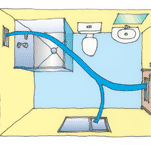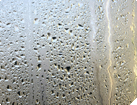Wet Areas
Poor wet area design or installation can compromise safety, comfort and convenience for building users, and lead to significant structural damage.
Managing temperature and condensation
Condensation can damage surfaces and materials and lead to fungal growth but it can be controlled through a combination of ventilation, heating and insulation.
On this page:
- Passive ventilation
- Active ventilation
- Heating
- Insulation
Wet area use, particularly showering, bathing, cooking and clothes drying, generates high levels of moisture into the air. If it is not removed, moisture in the air will condense as water when it comes into contact with cold surfaces.
Condensation:
- creates the potential for fungal growth
- steams up windows and mirrors
- causes deterioration of moisture-sensitive materials, fittings and fixtures.
Condensation can be managed by a combination of ventilation, heating and insulation.
Acceptable Solution E3/AS1 provides a means of preventing fungal growth by requiring: minimum R-values for walls, roof or ceiling; ventilation to comply with Acceptable Solution G4/AS1; and condensation control for metal windows. Applying this Acceptable Solution will also help to reduce deterioration of materials and other problems arising from condensation.
Passive ventilation
Passive ventilation by opening windows meets part of the minimum Building Code requirement for ventilation if the opening area of the window(s) is at least 5% of the floor area. Cross-flow ventilation from two windows on different walls is more effective but generally not possible. While passive ventilation is usually the main source of overall ventilation in occupied spaces, it is generally insufficient in rooms with cooktops, showers and baths.G4/AS1 requires mechanical air extract ventilation in these rooms.
Active ventilation
The most effective method of controlling moisture in the air in wet areas is a mechanical air extract vent that expels the moist air outside the house. G4/AS1 requires mechanical extract fans to remove moisture from rooms in household units and accommodation units that contain cooktops, showers and baths. The air must be exhausted to the outside. This may be direct through the wall, or may require ducting.
There are also ventilation requirements specifically for wet areas in all rental homes under the Healthy homes standards. You can find more details here.

- Bathroom ventilation
Principles of mechanical bathroom ventilation
The extract fan can be operated from a switch on the wall or by an automatic control such as:
- connected to the light switch (where the bathroom is an internal room)
- a timer switch that runs for a short period of time after the room is vacated
- an infrared sensor switch that responds to the room’s occupant
- a humidity sensor switch that responds to the room’s humidity levels.
En suite bathrooms are sometimes designed to be open to the bedroom and/or the walk-in wardrobe and require good directional ventilation to prevent high humidity air from migrating to these spaces.
Installing a plastic dome over the shower will also reduce the amount of steam that enters the room.
Also see active ventilation.
Heating
As air warms up, it can hold more moisture - so using heaters in wet areas can reduce condensation.
Ideally, bathrooms require two types of heating:
- Background heat to lower the relative humidity.
- Short period heat during use.
When considering options, performance should be considered alongside energy use. See space heating for more detail.
Options for bathroom heating
| Type of heating and heat delivered | Points to consider |
| In-slab • Heats the slab and may be part of a whole-house heating system. • Can heat the whole room to the required temperature all the time. • May use off-peak energy for electric cable systems. |
• Warms the whole room for personal comfort. • Takes up no wall space. • May be expensive depending on how it is used |
| Under floor tile heating • Thin electrical heating elements built in between the structural floor and the tiled surface. |
• Provides a warm floor, but does not necessarily heat the room space. • Can be used with a timer for more energy efficiency. • Takes up no wall space. |
| Panel radiators • Part of whole-house hot water radiator system or individual electric heater. • Radiated heat and some convected heat - proportions differ with the type. |
• Warms the whole room for personal comfort. • Can work on a thermostat to reduce power consumption. • Can be used with a timer for more energy efficiency but then does not heat the room. • Takes up wall space. |
| Radiant heaters – electric bar heaters or infrared heat lamps • Radiated heat. • Some proprietary infrared types are combined with an extract fan. |
• Gives personal comfort by an immediate warming effect. • Uses power only when the heater is in use. • Mounted at high level so takes up no wall space. • Does not heat the room. |
| Warm air heating – electric fan type heater • Warmed air is circulated by fan. |
• Heats the space fairly quickly • Uses power only when the heater is in use. |
| Warm air heating – heat pump or pellet burner • Part of a whole-house ducted air system. • Warmed air is delivered from the positive pressure system. |
• Not an efficient use of energy because full bathroom heating is not required all the time. • Does not take up wall space. • Warms the whole room. |
| Heated towel rail – oil filled electric • Convected heat. |
• Can give sufficient background heat to a well insulated room. • Dries towels. • Does not deliver sufficient heat for personal comfort. |
Insulation
Building Code clause H1 Energy efficiency requires that: “The building envelope enclosing spaces where the temperature or humidity (or both) are modified must be constructed to – (a) provide adequate thermal resistance; and (b) limit uncontrollable airflow.”. Acceptable Solution E3/AS1 sets out minimum R-values for walls, roofs and ceilings, which may be less than that required to comply with clause H1.
BRANZ recommends that R-values should be maximised wherever possible. In addition, insulation must be correctly fitted and have cold bridges minimised. See insulation for details.
BRANZ also recommends specifying the best-performing windows the client can afford. The additional cost will be offset by long-term energy savings, and of course the home will be more comfortable to live in. With aluminium frames, opt for frames with a thermal break and a thermally improved spacer.
With a thermal break, the inner and outer parts of the metal frame are held together by a connection with very low thermal conductivity – typically an extremely tough and durable type of reinforced plastic. This feature significantly reduces heat transfer through the frame and reduces the risk of condensation forming.
Spacers separate the glass panes in a double or triple/y can be made of aluminium, it is much better if they are made from a material with much lower thermal conductivity that reduces heat loss.
Updated: 28 November 2022


